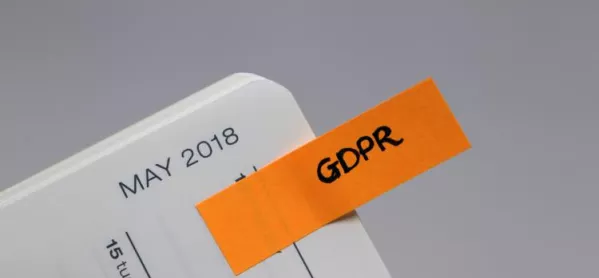- Home
- ‘Could GDPR cut teacher workload?’
‘Could GDPR cut teacher workload?’

The introduction of the General Data Protection Regulation (GDPR) has been a nerve-racking experience. Administrators have spent many hours leading training sessions for teachers so that all the risks are highlighted and all the precautions are taken. We’ve ingrained the advice on the safe use of emails (check addresses carefully and ensure no further previous correspondence is forwarded to the wrong parties) in our already-packed brains.
School and college systems and other large institutions, such as the NHS and banks, are at constant risk of an attack; it’s a headache for IT professionals to keep virus protection up to date. Given the penalty for a data breach (4 per cent of the annual turnover maximum fine), no school can take avoidable risks.
Therefore, so far, most of the extra effort to keep data secure has been borne by the administrators and senior leaders.
However, recent developments in practice may be even more far-reaching. One approach is to define pupils’ exercise books as sensitive data. Some schools have been instructed that teachers should not take exercise books home on public transport to cut the risk of a data breach.
The implications of this directive are many and interesting. It’s hard to see how the loss of an exercise book, lamentable as it would be, could in any way equate to the consequences of 64,000 examiners for one awarding organisation having some of their data hacked in a cyber-attack like AQA did in 2017.
However, there might be a silver lining to this particular cloud. Many teachers are unable to walk, cycle or drive into school so will be unable to take work home. A solution requiring all teachers to avoid public transport when transporting pupils’ work is impractical. Other arrangements may need to be made if pupils’ work is to be assessed in order to provide data for planning and monitoring purposes.
GDPR could reduce marking
Since reports from as early as 2016 indicate that teachers spend more than 11 hours marking every week - the equivalent of more than one extra day - some reduction would be needed, unless schools plan to open on Saturdays for the work to be done. Even requiring teachers to remain on premises to complete the marking would not be sufficient.
But it would certainly make the marking bit of the workload iceberg under the surface more visible. Tagging two hours on to the end of each day to get marking completed would mean teachers being in school working for as much as 10 hours a day. As many teachers do lunch duties and run clubs, attend meetings and see pupils in the middle of the day, it seems reasonable to include that time. This would mean a 45-50 hour week before you even take “invisible” duties, such as answering emails, lesson-planning and entering data, into consideration.
The disadvantages of an extended day for working parents and for those commuting longer distances are obvious. So another, smarter way would need to be found.
One solution to the current workload crisis is the limiting of working hours, as is being trialled by authorities like Nottingham City Council. Leaders would have to evaluate current practice to see which assignments are really necessary. Could there be fewer set, for example?
Alternatively - or additionally - subject leaders could look at the way assignments are marked. How much detail is needed to show how well pupils are progressing? The usual blanket coverage might be reduced, and clear success criteria used. The Education Endowment Foundation’s report A Marked Improvement cites this as one key way of improving the quality of assessment.
A quick win for both pupils and teachers would be to stop triple marking and dialogic marking. So far there is no research showing that such intensive and time-consuming measures have produced gain over other methods.
Or perhaps this would be a good time to look at effective in-class assessment, with greater value placed on spoken feedback. Involving pupils in the marking would make large efficiency savings. If there are 30 pupils in a class and each piece of work takes about 15 minutes to mark, then 450 minutes of teacher time could be saved. Even where schools are reluctant to place the whole onus on pupils for the marking, it would take teachers considerably less time to endorse or correct misapprehensions than to do the whole lot from scratch.
This also allows for the “learning journey” to continue. In the past, pupils might have considered the assignment over once it was handed into the teacher, but this way they would see how others do, understand the criteria better and get involved in setting the next steps.
GDPR will be with us for a long time to come - its implementation is already very different across trusts, authorities and other bodies. Change always brings with it the disadvantage of increased effort, at least in the early stages. However, if as well as ensuring that sensitive information is not shared with the wrong parties, GDPR could also make teacher workload more visible, then perhaps this will act as an incentive to streamline outmoded and unnecessary intensity of effort.
Yvonne Williams is a head of English and drama working in the south of England
Keep reading for just £1 per month
You've reached your limit of free articles this month. Subscribe for £1 per month for three months and get:
- Unlimited access to all Tes magazine content
- Exclusive subscriber-only stories
- Award-winning email newsletters



